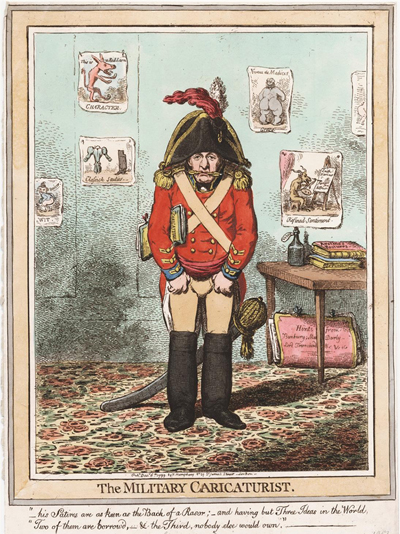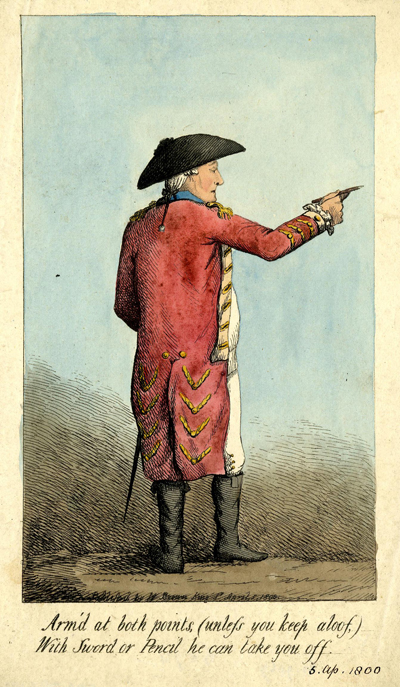The Military Caricaturist
The British Museum commentary, following Thomas Wright and R.H. Evans, identifies the hapless subject of this print as Thomas Davies (~1737-1812), an officer in the army and an amateur landscape artist, naturalist, and caricaturist, who was "reputed to have spoken slightingly of Gillray."

© Lewis Walpole Library, Yale University
In the 18th century, a talent for drawing was a valuable asset in a soldier. Accurate depictions of topography were essential for the military, especially in the uncharted regions of Canada and America where Davies was stationed during the French and Indian War and the later American revolutionary war. Most of Davies' surviving work consists of rather attractive graphite and watercolour."views" of areas of wartime interest or records of actual engagements.
In 1790, however, Davies was back in England and in 1796 promoted to Colonel of the Artillery. Like the soldier aristocrat George Townshend before him, Davies seems to have turned his talents from topography to people and begun a new career in caricature. An anonymous portrait caricature from 1800, plays upon his dual skills in soldiering and sketching. But I have been unable to find actual examples of caricatures by Davies which would support Gillray's judgment.

© Trustees of the British Museum
Gillray first portrayed Davies as a soldier reviewing his troops in The Salute (July 10, 1797). In that print, one of the officers under Davies' command, is saluting with the wrong hand, another bears a questionable flag, and the third seems half-asleep, so Davies had some cause to resent Gillray's design. But he was certainly ill-advised to make his feelings widely known. He should have learned from the example of John Boydell in Shakespeare Sacrificed and Philip Thicknesse in Lieut Goverr Gall-Stone that Gillray was never one to suffer aspersions on his art without redress. And in The Military Caricaturist he exacts his revenge.
Davies is shown looking sourly face forward, a double-ended chalk/crayon holder (porte crayon) between his teeth and his portfolio (labeled caricatures) under his arm. The lines of his military bicorne hat, rounded shoulders, arms and hands with thumbs inserted in the narrow fall of his breeches form an oval or egg-shape, perched upon two booted legs. If that were not unflattering enough, Davies is surrounded by pitiful examples of his work on the wall behind him intended to demonstrate his incompetence as a draughtsman.
A donkey-like figure supposed to be a lion is labeled "Character." A grotesquely obese figure supposed to represent the Venus de Medici is titled "Grace." A young woman presenting her bare bottom to be kissed is labeled "Wit." And a still life of a coat and boots is titled "Classick Studies."
But artistic incompetence is only the first of several judgments lodged against Davies. Under the table to Davies' left is a bulging portfolio inscribed "Hints From Bunbury; Ma[tthew] Darly – Lord Townshend, &, &, suggesting that Davies plagiarizes most of his caricatures from the acknowledged experts in the field. That point is further reinforced by the caption beneath the image: "his Satires are as keen as the Back of a Rasor;_ and having but Three Ideas in the World, Two of the are borrow'd,_ & the Third, nobody else would own.
And from the objects on and above the table, we can surmise the third "Idea" that "nobody else would own" is pornography. Aretino's Postures was a famous guidebook of sexual positions. La Pucelle was a satiric poem by Voltaire notorious for its sexual content. And the bottle tagged "Velno" contains a well-known supposed remedy for veneral disease. Finally, the picture above the table with its goatish artist suggests that the "Refined Sentiment" in the portrayal of a reclining nude is just a cover for its sexual titillation, especially when it originates from a naval sea port like Leith Harbor.
Sources and Reading
- Commentary from the British Museum on The Military Caricaturist.
- "Thomas Davies (British Army officer)," Wikipedia
- Thomas Davies Dictionary of Canadian Biography
- The Art of Thomas Davies
- "I Modi [Aretino's Postures]," Wikipedia
- "The Maid of Orleans (poem)," [La Pucelle d'Orleans] Wikipedia
- Thomas Wright and R.H. Evans, Historical and Descriptive Account of the Caricatures of James Gillray #447.
- Thomas Wright and Joseph Grego, The Works of James Gillray, the Caricaturist; With the History of His Life and Times, p. 267.
Comments & Corrections
NOTE: Comments and/or corrections are always appreciated. To make that easier, I have included a form below that you can use. I promise never to share any of the info provided without your express permission.